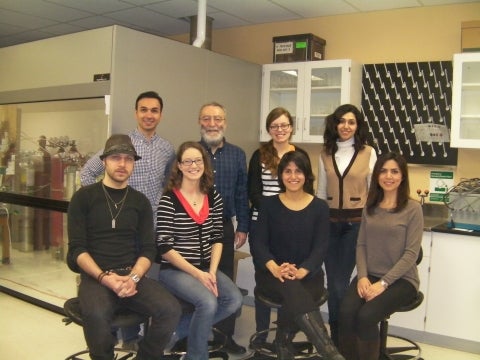About a year ago, several news outlets published stories with playful headlines that included “Static electricity helps geckos get a grip,” and “Shocking! Geckos use static electricity to stick to walls.” The discovery by researchers at the University of Waterloo behind all those stories, however, has much bigger implications that could include breakthroughs in everything from art restoration to car tires to medical applications such as promoting wound healing.
Under the direction of Professor Alexander Penlidis of the Department of Chemical Engineering and the Institute for Polymer Research, graduate student Hadi Izadi’s (PhD 2014, Chemical) PhD project started with the idea to fabricate “dry adhesives" mimicking the way geckos’ feet can stick to surfaces. Working with Teflon-like materials (fluoropolymers), the resulting dry adhesive was not only able to function as desired under dry conditions but even under water. This strong adhesion in dry conditions, however, lead to a more in-depth investigation that turned existing theories about gecko adhesion dating back to the 1930s on their head.

“Our study basically showed that an effective dry adhesive, like gecko toe pads, not only needs small hairs to develop an intimate contact, but also needs to become effectively charged upon contact,” Penlidis explains. “This research is not only important in terms of introducing a new perspective in analyzing the interfacial interactions of both natural and synthetic dry adhesives, but it is also of fundamental significance for researchers with interests in exploiting the benefits offered by formation of contact electrification-driven electrostatic interactions in development of interfacially-active materials and devices, such as triboelectric nanogenerators, gecko-inspired dry adhesives, and touchscreen displays.”
Several examples of the applications of this exciting research include bandages and sutures that stick to (and detach from) wounds better to promote the wound healing process, Penlidis adds, or more effective grips on car and truck tires. Izadi, now a postdoctoral associate at Yale University, is continuing to research the potential of the discovery.
Penlidis describes his role as academic supervisor at Waterloo as “equal parts advisor, bouncer, cheerleader and oracle,” and suggests students need to think beyond the typical “carrots” of publishing papers for cash prizes and consider the ultimate goals of their research. Perhaps not surprisingly, he also uses his expertise in polymer reaction engineering and polymerization process scenarios as a way of describing his approach to teaching and helping students pursue their ideas.
“Engineering balance equations tell us that you get out what you put in,” he says. “The difference is that enthusiastic and inspired and motivated students will add new terms to the input and create additional ideas that improve the final outcome.”





